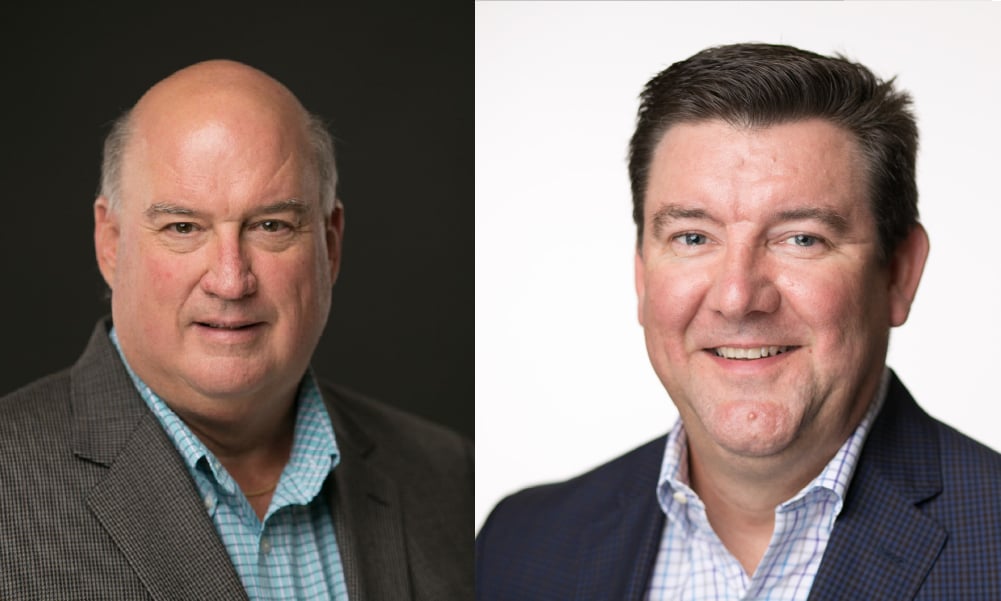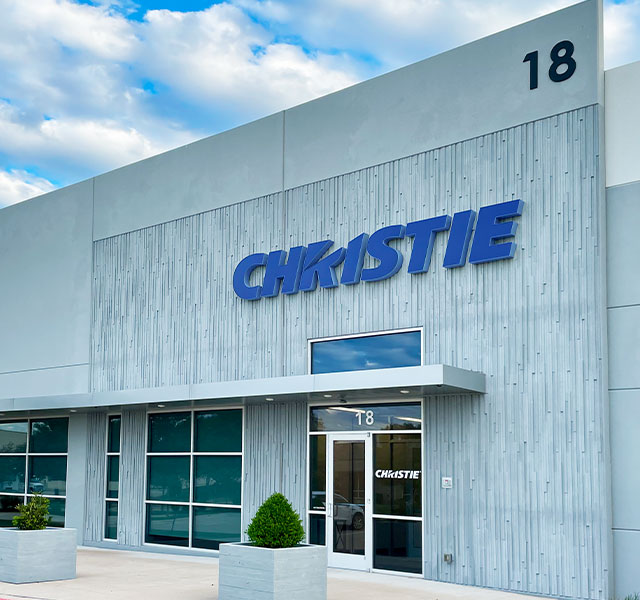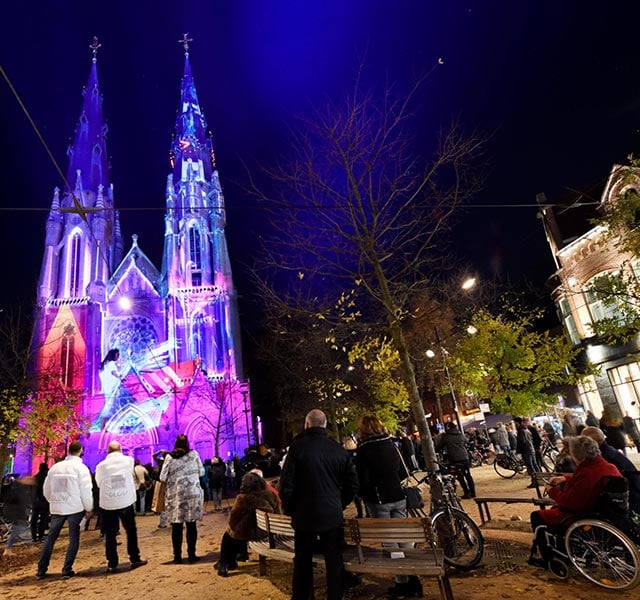A behind-the-scenes look at innovation at Christie
In 2022, Christie acquired Brass Roots Technologies (BRT), an Allen, Texas-based technology and engineering company. While the acquisition meant that BRT staff joined Christie, we had been collaborating with BRT for years.

BRT was at the forefront of designing and engineering advanced optics and worked with Christie to develop technologies that were critical to the success of many of our products. Before that, Frank Poradish and Wayne Reynolds developed game-changing technologies at Texas Instruments.
Now, Frank Poradish, our Chief Scientist, and Wayne Reynolds, our VP of Industrial Applications, talk about their backgrounds, creating BRT, their roles at Christie, and the exciting trends and developments they see in optical and mechanical design.
Let’s start at the beginning. Could you tell us a little about yourselves and your background?
Frank Poradish (FP): I spent the first 30 years of my career at Texas Instruments (TI), where I was recruited right out of college. I was hired into a group at TI that was working with the Skunk Works at Lockheed Martin on advanced radar and electronics systems for stealth and counter stealth. I learned a lot.
In the second half of my TI career, I worked on developing DMDs and DLP® technology. We changed the world with DLP Cinema technology. I met Christie during those days of 3-chip DLP projectors and DLP Cinema developments.
Wayne Reynolds (WR): I’m a Texan, and I grew up here in the Metroplex [the Dallas-Fort Worth Metropolitan Area]. I completed my BA and MSc in electrical engineering at the University of Texas at Arlington and earned an MBA at the University of Texas at Austin.
I spent nearly 14 years at Texas Instruments, the first five of which were as a systems and applications engineer developing analog servo devices. After I completed my MBA in 2000, I moved to DLP and transitioned to product management and business development. I was on the Pro Venue side of DLP Cinema, and that’s where I first met Frank and Brad Walker [principal product developer, Christie]. That’s also when I started calling on Christie. After leaving TI, I joined BRT as a partner in 2010 and later became president in 2021.
Could you talk about DLP and DMD technology? In short, how does it work?
FP: I started working on DLP at the very beginning and it was the most impossible thing anyone had ever seen. Everyone thought we were crazy. I was the first mechanical engineer to be assigned to DLP.
In those early days, DLP was very problematic. It was invented by a physicist, and it hadn’t been fully engineered. There were many elements that had to come together to make a product out of it. I helped solve the mirror hinge problem, designed some of the original packages, and designed the original prism optics. I have a number of patents, which are still in use.
WR: Here’s a quick overview of DLP technology. DLP, which stands for Digital Light Processing, is a chipset that includes a DMD chip, or Digital Micromirror Device. A DMD is an array of up to 8 million micromirrors that are each individually controlled.

Light reflects off the digital micromirrors, each acting as a single pixel in the resolution of a projected image. Each pixel can be turned ‘on’ or ‘off’, and a linearly controlled grayscale results when switching back and forth at a given duty cycle.
In a single-chip system, the DMD timeline is sequentially split into different color segments, which the human eye perceives as a full-color image. A 3DLP® projector uses three DMD chips, one dedicated to each of the red, green, and blue colors. DMDs have incredible data bandwidth that allow the mirrors to be independently switched several thousand times per second, resulting in astounding image quality and performance. Optical power handling and reliability are also hallmark strengths of DLP.
After TI came Brass Roots Technologies (BRT). Could you tell us about BRT?
FP: I created BRT in 2009. I wanted to set up BRT like a skunkworks company, similar to the work I originally did at TI: by putting smart people together to work on projects that everybody thought were hard or impossible.
BRT wanted to take DLP to new levels. We knew how DLP worked because we helped develop it. The mainstream market only needed a small percentage of a DMD’s performance, but the DMD was so much better than that. Our backgrounds in optics and electronics made us good architects of this kind of challenge – to take DMDs to the limits of their performance.
So, the question became, ‘what else can we do if we actually design it [the DMD] to go as fast as its potential?’ We started playing with it and learning about artifacts and high frame rates.
WR: We always wanted to take DLP beyond the ‘standard’ markets that the chipset products were oriented towards. TI has always excelled at supporting mainstream markets with DLP chipsets tailored to specific performance requirements.

But when you look at an application like simulation, for example, it’s not a large worldwide market and it has very demanding requirements far in excess of mainstream applications. It’s therefore a difficult market for TI to profitably serve, but it was a perfect fit for a small, nimble design firm like BRT. The performance we were able to deliver by using the full bandwidth and performance potential of the DMD was off the charts and extremely well received in that space.
Over the years, we applied the same formula to a variety of exotic, performance-demanding applications to enable very differentiated solutions for BRT’s clients.
Could you give an example of the type of technology that BRT developed?
FP: BRT had a great understanding of DLP, optics, electronics, mechanical packaging, and algorithms, and we looked at problems from the system level to come up with the best balance of technologies to achieve our goal.
With this approach, and our backgrounds, we developed enabling technology to produce several firsts: a WQ 120Hz four-color 1-chip simulation projector, 4K projectors running at 120Hz, 240Hz, and 360Hz, and an 8K, 60Hz projector.
How did BRT come to work with Christie?
FP: Christie was BRT’s first customer and they wanted me to grow the company to do more.
I had learned that the right group of people can come up with amazing things if given the resources and opportunity. So, Brad Walker and Wayne became partners in 2010 and we hired a bunch of other smart people to work on taking our knowledge and tech blocks into the highest-performance niche markets.
Christie loves high-performance products and applications, so we were a good match!
Could you give an example of the type of products or solutions BRT worked on for Christie?
FP: One of the first projects we worked on for Christie involved adding touch detection to the original MicroTiles®. We built a prototype version in Brad Walker’s garage! We also worked on high-frame rate projectors with Christie starting in 2011.
Our knowledge and experience with DLP, optics, and electronics, and how to put those together, made us very effective at balancing those things and coming up with higher-performance DLP products.
We wanted to take DLP to new levels. We knew how DLP worked because we helped develop it. Our backgrounds in optics and electronics made us good architects of this kind of challenge.
Frank, as our Chief Scientist, are there any recent innovations at Christie that you’re especially proud of?
FP: Christie has done some outstanding work with high-performance HFR and HDR projectors. BRT helped with some of these developments, but Christie has done many more innovations on its own, which I am proud of because I am now a Christie employee. It takes a village.
I believe Christie is leading the industry with the most efficient projectors and projectors that offer the highest image quality. The latest laser illumination technology and HDR optics are things we used to dream about but weren’t available until recently.
Wayne, could you talk about the type of work you do as VP of industrial applications?
WR: At Christie, I lead the effort in industrial applications. By definition, the charter for industrial apps is anything ‘non-display’ but we are primarily focused on two application areas: 3D printing and maskless lithography.
These are incredibly vast and complex markets with many different facets. We are working to understand the norms and needs of each space and craft a viable market entry strategy for Christie to participate. The exciting part is that industrial applications represent entirely new and additive business opportunities for Christie. Although we are certainly not first to these markets, we are well positioned here because both opportunities lean heavily on already existing engineering competencies within Christie.
Let’s look ahead. Are there any trends in optical or electrical design that you’re excited about?
FP: Absolutely! There are many exciting things in the works. The latest DLP technology is achieving new levels of performance that will enable many new applications and performance levels previously thought impossible.
We’re also seeing some exciting developments with photopolymers. A photopolymer is a material that changes properties when exposed to light, like when a dentist uses light to cure the fillings in your teeth.
On a larger scale, photopolymers are used in modern manufacturing, which has to control both heat and illumination. So, I think there could be some interesting developments with light across the spectrum – from UV to IR [infrared] – using LED or projectors to improve manufacturing processes. This is a growth market.
Our industry is poised to take a major step forward in performance as well as cost reduction. It’s very exciting. I wish I were young again.
WR: The most important technology trend I follow is the onset of Artificial Intelligence, or AI. We first started exploring applications of AI in BRT a few years ago, which meant investing in new and different competencies. We were able to successfully apply that investment to a customer project with great success.
But AI is a technology train that never stops. The advancements making mainstream headlines today are the result of an incomprehensibly large, decades-long body of work across industry and academia to advance computer technology and develop the theories, models, and software frameworks, all of which underly the advancements we see today.
AI is extremely disruptive to every industry, and companies will soon be distinguished and compared by the extent to which they embrace and use this technology.
Is there anything else you’d like to share?
FP: Christie and BRT collaborated on a lot of great projects over the years, bringing several ‘industry firsts’ to the market. There are still many great works yet to do. We hope to further explore what we can do with these new technologies and the great expertise at Christie, to continue to be at the forefront of display and other new technologies.



